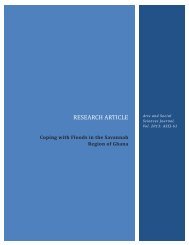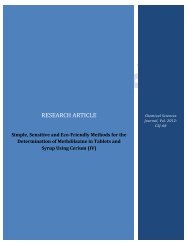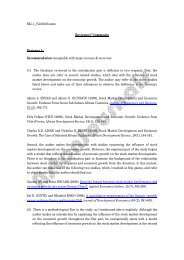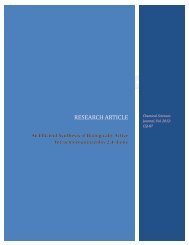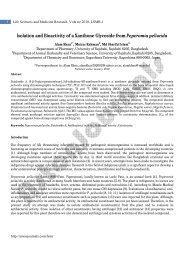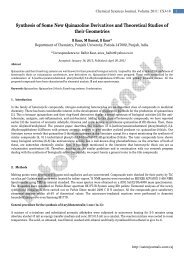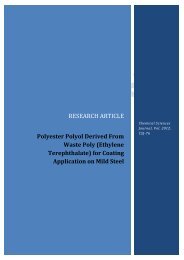Development of RAPD Markers linked to Fusarium ... - AstonJournals
Development of RAPD Markers linked to Fusarium ... - AstonJournals
Development of RAPD Markers linked to Fusarium ... - AstonJournals
Create successful ePaper yourself
Turn your PDF publications into a flip-book with our unique Google optimized e-Paper software.
Genetic Engineering and Biotechnology Journal, Vol. 2011: GEBJ-281<strong>Development</strong> <strong>of</strong> <strong>RAPD</strong> <strong>Markers</strong> <strong>linked</strong> <strong>to</strong> <strong>Fusarium</strong> Wilt ResistanceGene in Cas<strong>to</strong>r Bean (Ricinus communis L)M Singh 1 *, I Chaudhuri 1 , SK Mandal 2 , RK Chaudhuri 11 Plant Molecular Biology Labora<strong>to</strong>ry, Botany Department, University <strong>of</strong> Calcutta, Kolkata, India.2Microbiology Labora<strong>to</strong>ry, Pharmaceutical Division, Jadavpur University, Kolkata, India.*Present address: School <strong>of</strong> Biotechnology & Life Sciences, Haldia Institute <strong>of</strong> Technology, Haldia,West Bengal, India.*Correspondence <strong>to</strong>: Mukesh Singh, singhmukesh8@rediffmail.comAbstractAccepted: September 1, 2011; Published: November 11, 2011Wilt, caused by <strong>Fusarium</strong> oxysporum f. sp. ricini, is the most severe disease <strong>of</strong> cas<strong>to</strong>r bean (Ricinus communis). For thedevelopment <strong>of</strong> marker for wilt-resistant gene, 200 F 2 individuals from a cross between the resistant cultivar 48-1 and thesusceptible cultivar VP-1 were inoculated with a race <strong>of</strong> <strong>Fusarium</strong> oxysporum f. sp. ricini. Bulked segregant analysis wasused <strong>to</strong> search for random amplified polymorphic DNA (<strong>RAPD</strong>) markers <strong>linked</strong> <strong>to</strong> wilt resistance in F 2 progeny derived fromthe above cross. Three markers (RKC 23 1375, RKC 21 1080 and OPBE 18 900 ) flanking the wilt resistance gene were identified.The developed markers segregated from the screened <strong>Fusarium</strong> wilt resistant progenies <strong>of</strong> F 2 and F 3 families confirmedtheir linkage with <strong>Fusarium</strong> wilt resistance and the resistant cas<strong>to</strong>r bean genotypes were successfully identified amongthirteen cultivars screened. Linkage analysis was carried out using the three markers on the 200 F 2 individuals whichshowed that the genetic distance for the three markers at the wilt resistance gene was 5 cM, 10.7 cM and 7.6 cMrespectively. The predicted protein 3D model <strong>of</strong> the translated amino acid sequence from RKC 23 showed characteristicfeatures <strong>of</strong> DNA binding protein (2BIN). This study provides a base for probable mining <strong>of</strong> <strong>Fusarium</strong> wilt resistance gene incas<strong>to</strong>r bean and simultaneously gives valuable insights in<strong>to</strong> the characterization <strong>of</strong> R-gene subclass in cas<strong>to</strong>r genome.Keywords: Cas<strong>to</strong>r bean; Marker-Assisted Selection (MAS); protein modeling; <strong>RAPD</strong> marker; susceptible.1. IntroductionIndia is the leading country among the vegetative oil producing countries in the world, accounting for over 64% <strong>of</strong> the global production followed by China and USA. Cas<strong>to</strong>r bean (Ricinus communis L, familyEuphorbiaceae) contains 50-55 % oil in seeds. The crop holds impressive position in the global oilseed scenarioaccounting for 19 % <strong>of</strong> the <strong>to</strong>tal area and 9 % <strong>of</strong> the <strong>to</strong>tal vegetative oil production [1]. Wilt disease <strong>of</strong> cas<strong>to</strong>rbean (Ricinus communis) is caused by <strong>Fusarium</strong> oxysporum f. sp. ricini. It is a major disease <strong>of</strong> the crop <strong>of</strong>tenresulting in loss <strong>of</strong> more than 80 % crop yield in India. Hybrid breeding approach is sometimes practiced <strong>to</strong>compact such yield, India has the cas<strong>to</strong>r bean improvement programmes under Direc<strong>to</strong>rate <strong>of</strong> OilseedResearch (DOR), Hyderabad, for developing high-yielding disease resistant varieties. Breeding <strong>of</strong> pathogenresistantcas<strong>to</strong>r is believed <strong>to</strong> be a better option <strong>to</strong> res<strong>to</strong>re the yield <strong>of</strong> this commercially important crop plant.Traditional breeding approaches in developing wilt-resistant genotypes are time consuming as well as costlyand it requires screening <strong>of</strong> the plants with test fungus, up <strong>to</strong> 7-8 generations. The time and cost may bereduced by adopting DNA marker assisted selection (MAS) process. Application <strong>of</strong> MAS leads <strong>to</strong> a quick andreliable analysis for susceptibility. Therefore, use <strong>of</strong> MAS, coupled with traditional breeding technique is thebest <strong>to</strong> combat plant diseases.Pathogen avirulence (Avr) genes have coevolved with the resistance genes. So, prevention <strong>of</strong> disease byindividual R-gene is not feasible. In this regard, tight linkage between a DNA marker and a disease trait has led<strong>to</strong> the successful transfer <strong>of</strong> resistant gene <strong>to</strong> a susceptible genetic background, <strong>of</strong>ten by building resistantgenes-pyramid in crop plants [2]. Though no genetic or linkage map is available for cas<strong>to</strong>r bean but,homozygous breeding lines with respect <strong>to</strong> wilt disease resistance are available at various breeding stationsacross the globe. They may help <strong>to</strong> tag resistant gene with molecular (DNA) markers. A number <strong>of</strong> DNAmarkers such as RFLP, <strong>RAPD</strong>, AFLP, and SCAR are available for MAS, <strong>to</strong> tag disease resistant genes [3-5].Amongst prominent MAS application are stem rust in barley [6], mosaic virus <strong>of</strong> <strong>to</strong>ma<strong>to</strong> [7], gall midgehttp://as<strong>to</strong>njournals.com/gebj
Genetic Engineering and Biotechnology Journal, Vol. 2011: GEBJ-283Four DNA bulks were prepared from equimolar amounts <strong>of</strong> DNA from 200 individual plants as follows: (1)resistant F 2 (F 2 R ) plants, (2) susceptible F 2 (F 2 S ) plants, (3) resistant F 3 (F 3 R ) plants, (2) susceptible F 3 (F 3 S ) plants.Uniform PCR amplification conditions were maintained. Among the 64 primers screened, primers showingpolymorphism were selected <strong>to</strong> find out markers <strong>linked</strong> <strong>to</strong> the target locus using resistant and susceptiblebulks along with parental and check DNA. Segregation for number <strong>of</strong> diseased vs normal F 2 plants and theirrespective <strong>RAPD</strong> markers were evaluated by the χ 2 – test (p = 0.05) according <strong>to</strong> the Mendelian segregationratio <strong>of</strong> a single dominant inheritance fashion (3:1).Using the above mentioned <strong>RAPD</strong> primers, 13 cas<strong>to</strong>r bean cultivars were analyzed for polymorphism <strong>to</strong>discriminate them in<strong>to</strong> resistant and susceptible genotypes. Then they were tested in the sick plots <strong>to</strong> confirmthe use <strong>of</strong> these <strong>linked</strong> markers in identifying disease reaction in cas<strong>to</strong>r bean cultivars.2.5. Linkage analysisA preliminary screening for polymorphism <strong>of</strong> the molecular markers among the resistance parent (48-1) andsusceptible parent (VP-1), and their progenies, was carried out using 64 arbitrary decamer primers (Operon).Linkage map was constructed with the developed three <strong>RAPD</strong> markers data using MAPMAKER (Version 3.0)[30] Linkage groups were identified using minimum LOD value <strong>of</strong> 3. The mapping population consists <strong>of</strong> 200 F 2plants. Recombination values were transformed <strong>to</strong> linkage distances in centiMorgans (cM) by Haldane’smapping function.2.6. Elution <strong>of</strong> DNA fragments from gelAmplified DNA fragments <strong>of</strong> interest were eluted from the low melting agarose gel by using Bangalore GeneiElution Kit (Cat # KT 02) as recommended by the manufacturer for further amplification and sequencing.2.7. DNA sequencing and characterization <strong>of</strong> the markers<strong>RAPD</strong> was done with eluted DNAs using respective primers and the products were confirmed on a 1.6 % (w/v)agarose gel. An aliquot <strong>of</strong> the products were PCR-sequenced in an au<strong>to</strong>mated sequencer (ABI PRISM 377, PE).The sequences were analyzed by searching GenBank and EMBL accessions using BLASTN [31] at the websitehttp://www.ncbi.nlm.nih.gov/BLAST/. The sequences were subjected <strong>to</strong> the biocomputing <strong>to</strong>ol, Vec<strong>to</strong>r NT1Suite 6.0, and ExPASY Proteomics <strong>to</strong>ols for further analyzing and compilation. The amino acids sequences <strong>of</strong>the proteins were deduced from the nucleotide sequences using Expasy Server. Alignment <strong>of</strong> proteinsequences with the sequences deposited in the databases was done by Clustal W program. The predictedprotein sequence from FOR1 sequence was used <strong>to</strong> build the three dimensional structures <strong>of</strong> the proteinsusing Rossetta server by ab ini<strong>to</strong> method, as there was no detectable sequence homology between proteins <strong>of</strong>known 3D structures. Nucleotide sequence <strong>of</strong> the characterized DNA marker was deposited as GenBankaccession number BankIt1359615Seq2HM748464.3. Results3.1. Phenotyping <strong>of</strong> F 2 and F 3 populations segregating for <strong>Fusarium</strong>-wilt reactionA <strong>to</strong>tal <strong>of</strong> 200 F 2 plants were forcibly inoculated by root-tip inoculation method and screened for wilt diseasein glasshouse conditions, and the results were illustrated in Table 1. The observed segregating pattern fitsalmost perfectly a 3:1 ratio, for resistant and susceptible progenies, which were in agreement with thepresence <strong>of</strong> single dominant gene in the fusarium-wilt resistant parent and F 2 individuals. <strong>Fusarium</strong>-wiltresistant <strong>of</strong> F 3 plants were analyzed, almost all the F 3 plants that were from the randomly selected resistant F 2plants were designated as phenotype resistant and plants which were derived from 3 resistant F 2 plant seedssegregated in<strong>to</strong> resistant and susceptible genotypes. These results showed all F 2 plants from which F 3population was formed were homozygous, except for the 3 F 2 plants which segregated for the fusarium-wiltresistant gene. The 3 F 2 plants were heterozygous for the same gene.http://as<strong>to</strong>njournals.com/gebj
4 Research ArticleTable 1: Co-segregation <strong>of</strong> <strong>Fusarium</strong>-wilt reaction on forced inoculated F 2 individuals (200) <strong>of</strong> cas<strong>to</strong>r beanhybrid, GCH-4 and the three <strong>RAPD</strong> markers.F 2 Population χ2 Probability RecombinationResistance (R) Susceptible (r) (3:1) FractionPhenotyping <strong>of</strong> F 2F 2 Individuals 144 56 0.91 0.05Genotyping <strong>of</strong> F 2<strong>RAPD</strong> Marker RR Rr a rR b rr Rr a rR bOPBE 18 146 6 4 44 0.42 0 0.015 0.010RKC 21 137 9 6 48 0.61 0 0.023 0.015RKC 23 140 5 10 45 0.59 0 0.013 0.025r a Phenotyically resistant but devoid <strong>of</strong> DNA markers.R b Phenotyically susceptible but contains DNA markers.3.2. <strong>RAPD</strong> screeningA <strong>to</strong>tal <strong>of</strong> 64 arbitrary decamer primers were used for <strong>RAPD</strong> analyses for detecting variability amongst theparents. The number <strong>of</strong> amplified products by each primer varied from 0 <strong>to</strong> 31 with an average <strong>of</strong> 13.8 bandsper primer, and the amplified products ranges from 200 bp <strong>to</strong> 2100 bp. Only the easily scorable and consistentpr<strong>of</strong>ile <strong>of</strong> the <strong>RAPD</strong> was analyzed for all the primers used. The percent polymorphism was from 0–100 %. TheF 2 and F 3 segregating populations <strong>of</strong> GCH-4 along with the two parents viz. 48-1 and VP-1 were screened with104 <strong>RAPD</strong> primers for fusarium-wilt reaction under forced inoculation conditions. Three replica analyses foreach experiment were performed. Among the primers showing polymorphism between the two genotypes,only three primers, viz OPBE 18, RKC 21 and RKC 23, were selected for further studies, since they generatedamplification products that were present in resistant parents and resistant bulks but absent in susceptibleparent and susceptible bulks. The polymorphism was confirmed by repeated amplification experiments bycomparing with parents, resistant and susceptible bulks. The F 2 and F 3 bulk segregated analysis for theresistance locus, resulted <strong>to</strong>, 1:1 segregation ratio.3.3. Genotyping <strong>of</strong> F 2 and F 3 populations segregating for <strong>Fusarium</strong>-wilt reactionThe polymorphic primers OPBE-18, RKC 21 and RKC 23 were used <strong>to</strong> know the genotypes <strong>of</strong> the individuals <strong>of</strong>known phenotypes (fusarium-wilt resistant) from the F 2 population and F 3 population. The OPBE18 primergenerated 900bp DNA band for all the fusarium wilt resistant 146 out <strong>of</strong> 200 F 2 individuals, which followed thesegregation ratio <strong>of</strong> almost 3:1 (Table 1). This primer generated 900bp band in 92 F 3 resistant individuals out <strong>of</strong>100 plants tested for fusarium wilt reaction. The 3 randomly selected F 2 plants whose progenies weresegregated for the resistant gene were heterozygous and the non-segregated seeds <strong>of</strong> rest F 2 plants werehomozygous for the fusarium-wilt resistance gene. Similarly, RKC-21 and RKC-23 generated 1080 bp and 1375bp DNA bands in F 2 and F 3 individuals respectively whose segregation followed the simple Mendelianinheritance (Table 1). Linkage analysis carried out on the 200 F 2 individuals showed the genetic distance for thethree markers (RKC 23 1375, OPBE 18 900 and RKC 21 1080 ) <strong>linked</strong> <strong>to</strong> the wilt resistance gene as 5, 10.7 and 7.6 cMrespectively, calculated as described in materials and methods (Figure 1).3.4. DNA marker sequence analysis<strong>Development</strong> <strong>of</strong> DNA marker is essential in both marker-assisted selection and characterization <strong>of</strong> anyimportant gene, so the three markers developed in our report were sequenced and characterized. Homologysearches using GenBank and EMBL accessions using BLASTN showed that the three markers do not show anysignificant similarities <strong>to</strong> any <strong>of</strong> the accession in either <strong>of</strong> the databases. The sequences were modified byeliminating noncoding fragments by biocomputing <strong>to</strong>ols. Among the three markers sequences, the modified900 bp sequence <strong>of</strong> RKC 23 was characterized in details and was designated as FOR1. The modified sequencewas subjected <strong>to</strong> Translation <strong>to</strong>ol <strong>of</strong> the NCBI, <strong>to</strong> get the different frames. To assign possible biological function<strong>of</strong> the putative amino acid sequence <strong>of</strong> the modified RKC 23 marker, it was compared with the proteinsequences submitted in the publicly accessible databases and have shown significant similarities <strong>to</strong> theputative proline rich protein (Oryza sativa), PRP gene (Zea mays), cell division protein (Arabidopsis thaliana),nodule protein (ENOD2) (Pisum sativum). Secondary structure and fold recognition <strong>of</strong> the translated 3 / 5 / frame2 by Phyre databases gave some similarity with defensive-like protein (d1eLqa) from defensive family. Multiplesequence alignments and phylogram were generated using Clustal W alignment <strong>of</strong> the translated protein withother eight protein sequences. Translated amino acid sequence <strong>of</strong> marker RKC 23 and DNA binding proteinhttp://as<strong>to</strong>njournals.com/gebj
Genetic Engineering and Biotechnology Journal, Vol. 2011: GEBJ-285shared the same cluster in the phylogram. Enhancer sequence (GCTGTGT) is present at the position 735 bp.The predicted protein 3D model showed characteristic features <strong>of</strong> DNA binding protein (2BIN). The detailedand predicted 3D structure <strong>of</strong> that protein showed both α helices and β sheets. α helices have particularimportance in DNA binding motifs. This is because <strong>of</strong> the structural coincidence <strong>of</strong> size <strong>of</strong> α helix being thesame as the width <strong>of</strong> the major groove in the B-DNA (Figure 2).Figure 1: Linkage map <strong>of</strong> random amplified polymorphic DNA (<strong>RAPD</strong>) markers around FOR1 gene that confers resistance t<strong>of</strong>usarium wilt in cas<strong>to</strong>r bean (Ricinus communis). Molecular markers names containing the primer ID are on the right, anddistances indicated on the left side are estimated percent recombination between the markers (in cM), which are depictedas the maximum-likelihood solutions provided by MAPMAKER (version 3.0).3. DiscussionIn this report, the classical breeding methods and MAS worked <strong>to</strong>gether <strong>to</strong> tag the fusarium wilt markers<strong>linked</strong> <strong>to</strong> the wilt resistant gene in Ricinus communis L. The F 2 segregating GCH-4 progenies, out <strong>of</strong> a crossbetween 48-1 (resistant) and VP-1 (susceptible), segregated in<strong>to</strong> resistant and susceptible bulks. The resultsshowed expression <strong>of</strong> one dominant resistance gene in the F 2 resistant individuals under both natural andforced inoculation-screening conditions with the test fungus. The segregation <strong>of</strong> the locus for fusarium wiltresistance was true <strong>to</strong> Mendelian ratio <strong>of</strong> 3:1 (resistance: susceptible). Dweikat et al. (1997) [32] used <strong>RAPD</strong>markers for isolating insect resistance genes in wheat. Reports <strong>of</strong> a single dominant gene inheritance <strong>of</strong>anthracnose resistance [33, 34] and downy mildew resistance [15] were also reported. Using <strong>RAPD</strong> primers weassume here fusarium-wilt <strong>of</strong> R. communis L is controlled by a single dominant gene. The findings confirm thelinkage <strong>of</strong> DNA markers <strong>to</strong> fusarium-wilt resistance. It helps the development <strong>of</strong> <strong>linked</strong> <strong>RAPD</strong> markers(OPBE18 900 , RKC21 1080 and RKC23 1375 ). Recombinants were identified by the absence and presence <strong>of</strong> theabove said 900, 1080, and 1374 bp amplicons in the resistant and susceptible F 2 progenies respectively. Itconfirms the findings <strong>of</strong> Choudhury et al. (2002) on downy mildew disease <strong>of</strong> soyabean. The developedmarkers always segregated with the screened fusarium wilt resistant progenies <strong>of</strong> F 2 and F 3 families confirmingtheir linkage with fusarium wilt resistance. This study has established a linkage between three <strong>RAPD</strong> markersand fusarium-wilt 13 cultivars, which were screened here (Table 2).To obtain high accuracy <strong>of</strong> MAS for an agronomic trait, it is essential <strong>to</strong> have a high linkage with flankingmarkers [35, 36]. The presence <strong>of</strong> three DNA markers, which flank the fusarium wilt resistant gene, is a goodstart for MAS for cas<strong>to</strong>r bean fusarium wilt resistance breeding program. This is perhaps the first report <strong>of</strong>cas<strong>to</strong>r bean wilt resistant gene that is <strong>linked</strong> DNA markers. Short genetic distance <strong>of</strong> these markers from wiltresistance gene, designated as FOR 1, makes them potentially useful in marker-assisted selection. The detailedsequence analysis <strong>of</strong> FOR1 showed that it is a fragment <strong>of</strong> resistant gene. The homology search showedsimilarities with proteins like DNA binding Protein, PRP protein <strong>of</strong> Zea mays and early nodule protein. Theseedlings <strong>of</strong> the cas<strong>to</strong>r bean which were resistant <strong>to</strong> the test fungus, showed presence <strong>of</strong> nodule-like structureat the root-shoot transition region (result not shown). The similarities <strong>of</strong> Zea mays nodule protein sequencewith the predicted protein sequence <strong>of</strong> cas<strong>to</strong>r bean showed the role <strong>of</strong> nodule-like structure in defensemechanism.http://as<strong>to</strong>njournals.com/gebj
6 Research ArticleFigure 2: PCR amplification <strong>of</strong> a 1375 bp band with <strong>RAPD</strong> primer RKC 23 <strong>of</strong> resistance lines <strong>of</strong> Ricinus communis and itssequence characterization. A. Amplification obtained from RKC 23 <strong>RAPD</strong> primer <strong>to</strong> identify 1375 bp DNA fragment <strong>linked</strong> <strong>to</strong>the fusarium wilt resistance gene in Ricinus communis. Lane M, DNA marker 100 bp; Lanes 1-6 represents Resistanceparent (48-1), Susceptible parent (VP-1), F 2 resistance bulk, F 2 susceptilbe bulk, F 3 resistance bulk and F 3 susceptible bulk.B, Elution <strong>of</strong> 1375 bp DNA from 1.5% agarose gel. C, Reamplification <strong>of</strong> purified eluted DNA fragment with primer RKC 23.D, Phylogram <strong>of</strong> the translated amino acid sequence <strong>of</strong> the marker RKC 23 <strong>linked</strong> <strong>to</strong> wilt resistance gene, FOR1 and theeight homologous amino acid sequences. E and F, Ribbon structure and spacefilled models predicted 3D structure <strong>of</strong>protein translated from the sequence.http://as<strong>to</strong>njournals.com/gebj
Genetic Engineering and Biotechnology Journal, Vol. 2011: GEBJ-287Table 2: Detection <strong>of</strong> <strong>RAPD</strong> markers <strong>linked</strong> <strong>to</strong> fusarium wilt resistance gene in thirteen cas<strong>to</strong>r bean (Ricinuscommunis) cultivars <strong>to</strong> validate the developed three markers (RKC 23 1375, RKC 21 1080 and OPBE 18 900 ).Cultivars<strong>RAPD</strong> <strong>Markers</strong>RKC 23 RKC 21 OPBE 18 Reaction <strong>to</strong> wiltGCH 5 - - - SusceptibleRG 954 + - - SusceptibleM619 + + + ResistanceAruna - - - SusceptibleDCS 9 + + + ResistanceDCH 177 + + + ResistanceDCS 178 + + + ResistanceKranti - - - SusceptibleER 2 - - - SusceptibleLocal Red + + + ResistanceER 5 - - - SusceptibleGCH 4 + + + ResistanceDPC 9 + + + Resistance+ presence <strong>of</strong> DNA markers; - absence <strong>of</strong> DNA markers4. ConclusionYoung (1999) [10] reported <strong>to</strong> the plant breeders that it is more attractive <strong>to</strong> select desirable lines based ongenotype rather than analyzing phenotypes. If the three markers are detected in an individual, selectionefficiency for the gene will be almost cent percent, given that multiple cross-over between the markers occurat very low level <strong>of</strong> frequency. <strong>Markers</strong> <strong>linked</strong> <strong>to</strong> more resistant genes, obtained from different geneticbackgrounds, will enable one in pyramiding disease resistance found in different germplasm. Cloning andsequencing <strong>of</strong> these markers will make the development <strong>of</strong> sequence characterized amplified region (SCAR)markers feasible, <strong>to</strong> allow tagging <strong>of</strong> the resistance genes by PCR. The information on the sequences <strong>of</strong> thesemarkers will facilitate further investigations <strong>of</strong> wilt-resistant gene identification as well as MAS in cas<strong>to</strong>r plant.Not only this but also this result has a potential in the development <strong>of</strong> kit for quick detection <strong>of</strong> fusarium-wiltresistance gene in cas<strong>to</strong>r bean germplasms for crop improvement programmes.AbbreviationsBSA: Bulk Segregant Analysis<strong>RAPD</strong>: Random Amplified Polymorphic DNACompeting InterestsThe authors declare that they have no competing interests.Authors' ContributionsThe work is original and it has been carried out by MS for PhD dissertation under supervision <strong>of</strong> RKC and SKMin Jadavpur University, India. IC helped during the field and experimental works.AcknowledgementAuthors wish <strong>to</strong> acknowledge the materialistic support <strong>of</strong>fered by DOR (ICAR, India), DBT and UGC(Government <strong>of</strong> India) in the form <strong>of</strong> partial financial support. We also thank the scientists <strong>of</strong> DIC(Bioinformatics Centre), Bose Institute, Kolkata (India) for generating the 3D structure <strong>of</strong> predicted protein.References1. Sengupta K, Das PK, 2003. Cultivated Annual Oilseeds Crops <strong>of</strong> India. Naya Udyog, Kolkata.2. Singh SJ, Sidhu S, Huang N, et al., 2001. Pyramiding three bacterial resistance genes (xa5, xa23, xa21)using marker assisted selection in Indica rice cultivars, PR106. Theoretical and Applied Genetics, 102:1011-1015.http://as<strong>to</strong>njournals.com/gebj
8 Research Article3. Brar DS, 2002. Molecular marker assisted breeding. In Molecular techniques in crop Improvement. Editedby Mohan J, Brar DS, Ahloowalia BS. Kluer Academic Publishers, Dordrecht-Bos<strong>to</strong>n-London.4. Frisch MMB, Melchinger AE, 1999. Comparison <strong>of</strong> selection strategies for marker-assisted backcrossing <strong>of</strong>gene. Crop Science, 39: 1295-1301.5. Gupta PK, Varshney RK, Sharma PC, et al., 1999. Molecular markers and their application in wheatbreeding. Plant Breeding, 118: 369-390.6. Borokora IG, Steffenson DBJ, Rasmussen YJB, et al., 1995. Identification <strong>of</strong> molecular markers <strong>linked</strong> <strong>to</strong> thestem rust resistance gene rpg4 in barley. Phy<strong>to</strong>pathology, 85: 181-185.7. Ohmori T, Murata M, Moyoyoshi F, 1995. Identification <strong>of</strong> <strong>RAPD</strong> markers <strong>linked</strong> <strong>to</strong> the Tm-2 locus in<strong>to</strong>ma<strong>to</strong>. Theoretical and Applied Genetics, 90: 307-311.8. Nair S, Bentur JS, Prasada RU, et al., 1995. DNA markers tightly <strong>linked</strong> <strong>to</strong> a gall midge resistance gene(Gm2) are potentially useful for marker-aided selection in rice breeding. Theoretical and Applied Genetics,91: 65-78.9. Chowdhury AK, Srinivas P, Saksoong P, et al., 2002. <strong>RAPD</strong> markers <strong>linked</strong> <strong>to</strong> resistance <strong>to</strong> downy mildewdisease in soybean. Euphytica, 128: 55-60.10. Young ND, 1999. A cautiously optimistic vision for marker-assisted breeding. Molecular Breeding, 5: 505-510.11. Mayer MS, Abebe T, Simon CJ, et al., 1997. <strong>Development</strong> <strong>of</strong> a DNA marker for fusarium wilt resistance inchickpea. Crop Science, 37: 1625-1629.12. Ferreira ME, Williams PH, Osborn TC, 1995. Mapping <strong>of</strong> a locus controlling resistance <strong>to</strong> Albugo candida inBrassica napus using molecular markers. Phy<strong>to</strong>pathology, 85: 218-220.13. Oh J, Frederiksen RA, Magill CW, 1994. Identification <strong>of</strong> molecular markers <strong>linked</strong> <strong>to</strong> head smut resistancegene (Shs) in sorghum by RFLP and <strong>RAPD</strong> analyses. Phy<strong>to</strong>pathology, 84: 830-833.14. Thomas CM, Vos P, Zabeau M, et al., 1995. Identification <strong>of</strong> amplified restriction fragment polymorphism(AFLP) markers tightly <strong>linked</strong> <strong>to</strong> the <strong>to</strong>ma<strong>to</strong> Cf-9 gene for resistance <strong>to</strong> Cladosporium fulvum. The PlantJournal, 8: 785-794.15. Williams JGK, Kubelik AR, Livak KJ, et al., 1990. DNA polymorphisms amplified by arbitrary primers areuseful as genetic markers. Nucleic Acids Research, 18: 6531-6535.16. Carlson JE, Tulsieram LK, Glaubitz JC, et al., 1991. Segregation <strong>of</strong> random amplified DNA markers in F1progeny <strong>of</strong> conifers. Theoretical and Applied Genetics, 83: 194-200.17. Koller B, Lehmann A, McDermott JM, et al., 1993. Identification <strong>of</strong> apple cultivars using <strong>RAPD</strong> primers.Theoretical and Applied Genetics, 85: 901-904.18. Tinker NA, Fortin MG, Mather DE, 1992. Random amplified polymorphic DNA and pedigree relationships inspring barley. Theoretical and Applied Genetics, 85: 976-984.19. Datta J, Lal N, Kaashyap M, et al., 2010. Efficiency <strong>of</strong> three PCR based marker systems for detecting DNApolymorphism in Cicer arietinum L and Cajanus cajan L Millspaugh. Genetic Engineering and BiotechnologyJournal, Vol. 2010: GEBJ-5.20. Skaria R, Sen S, Muneer PMA, 2011. Analysis <strong>of</strong> genetic variability in rice varieties (Oryza sativa L) <strong>of</strong>Kerala using <strong>RAPD</strong> markers. Genetic Engineering and Biotechnology Journal, Vol. 2011: GEBJ-24.http://as<strong>to</strong>njournals.com/gebj
Genetic Engineering and Biotechnology Journal, Vol. 2011: GEBJ-28921. Zhang HY, Liu X, He Z, et al., 2005. Random amplified DNA polymorphism <strong>of</strong> Nicotiana tabacum L.cultivars. Biologia Plantarum, 49: 605-607.22. Haque I, Bandopadhyay R, Mukhopadhyay K, 2010. Population genetic structure <strong>of</strong> the endangered andendemic medicinal plant Commiphora wightii. Molecular Biology Reports, 37: 847–854.23. Amir HB, Keifi F, Mozafari J, 2010. Genetic differentiation <strong>of</strong> Crucus species by random amplifiedpolymorphic DNA. Genetic Engineering and Biotechnology Journal, Vol. 2010: GEBJ-18.24. Arya V, Yadav S, Yadav JP, 2011. Intra-specific genetic diversity <strong>of</strong> different accessions <strong>of</strong> Cassiaoccidentalis by <strong>RAPD</strong> markers. Genetic Engineering and Biotechnology Journal, Vol. 2010: GEBJ-22.25. Malviya N, Yadav D, 2010. <strong>RAPD</strong> analysis among pigeon pea [Cajanus cajan (L.) Mill sp.] cultivars for theirgenetic diversity. Genetic Engineering and Biotechnology Journal, Vol. 2010: GEBJ-1.26. Gupta R, Verma K, Joshi DC, et al., 2010. Assessment <strong>of</strong> genetic relatedness among three varieties <strong>of</strong> fingermillet with variable seed coat color using <strong>RAPD</strong> and ISSR markers. Genetic Engineering and BiotechnologyJournal, Vol. 2010: GEBJ-2.27. Ahmad G, Mudasir, Kudesia R, et al., 2010. Evaluation <strong>of</strong> genetic diversity in pea (Pisum sativum L) using<strong>RAPD</strong> analysis. Genetic Engineering and Biotechnology Journal, Vol. 2010: GEBJ-16.28. Rao<strong>of</strong> MA, Rao RG, Nageshwar, 1996. A simple screening technique for early detection <strong>to</strong> cas<strong>to</strong>r wilt.Indian Phy<strong>to</strong>pathology, 49: 389-392.29. Keim P, Olson T, Shoemarker RC, 1988. A rapid pro<strong>to</strong>col for isolating soybean DNA. Soybean GeneticsNewsletter, 15: 151-152.30. Lander ES, Green P, Abrahanson J, et al., 1987. MAPMAKER: an interactive computing package forconstructing primary genetic linkages <strong>of</strong> experimental and natural populations. Genomics, 1: 174–181.31. Altschul SF, Thomas LM, Alejandro AS, et al., 1997. Gapped BLAST and PSI-BLAST: a new generation <strong>of</strong>protein database search programs. Nucleic Acids Research, 25: 3389-3402.32. Dweikat IH, Patterson OF, Cambron S, 1997. Identification <strong>of</strong> <strong>RAPD</strong> markers for Hessian fly resistancegenes in wheat. Theoretical and Applied Genetics, 94: 419-423.33. Borra O, Ma<strong>to</strong>s AP, Cabral R, et al., 1998. Phy<strong>to</strong><strong>to</strong>xic effect <strong>of</strong> culture filtrate from <strong>Fusarium</strong> subglutinansthe causal agent <strong>of</strong> fusariose <strong>of</strong> pineapple (Annas comosus, L. Merr). Euphytica, 104: 73-77.34. Tenkouano A, Miller FR, 1993. A single locus with multiple alleles as the genetic basis <strong>of</strong> anthracnoseresistance in sorghum. Sorghum Newsletter, 34: 45.35. Milkas PN, Afanador L, Kelly JD, 1996. Recombination facilitated <strong>RAPD</strong> marker-assisted selection fordiseases resistance in common bean. Crop Science, 36: 86-90.36. Yencho GC, Cohen MB, Bryne PF, 2000. Application <strong>of</strong> tagging and mapping insect resistance loci in plants.Annual Review <strong>of</strong> En<strong>to</strong>mology, 45: 393-422.http://as<strong>to</strong>njournals.com/gebj


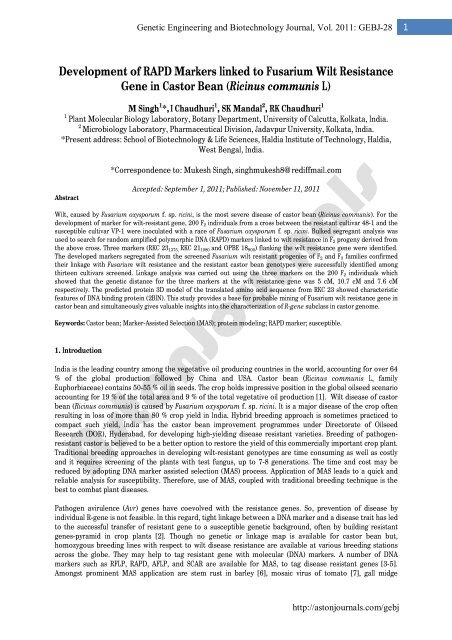
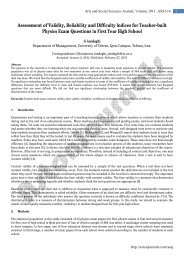
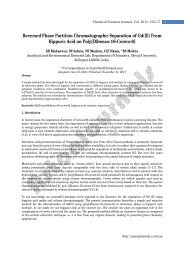
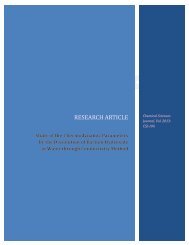

![[1,4]-benzodiazepine-2-one Derivatives as Potent - AstonJournals](https://img.yumpu.com/49117784/1/184x260/14-benzodiazepine-2-one-derivatives-as-potent-astonjournals.jpg?quality=85)
